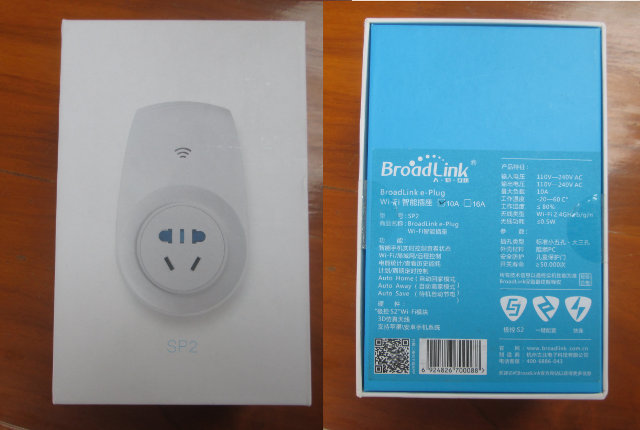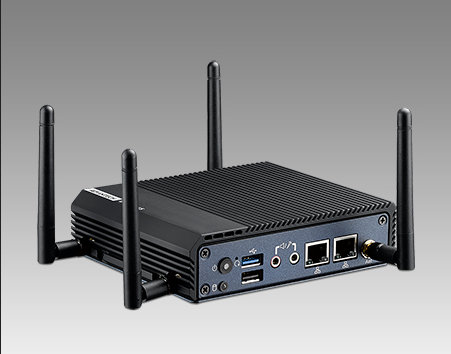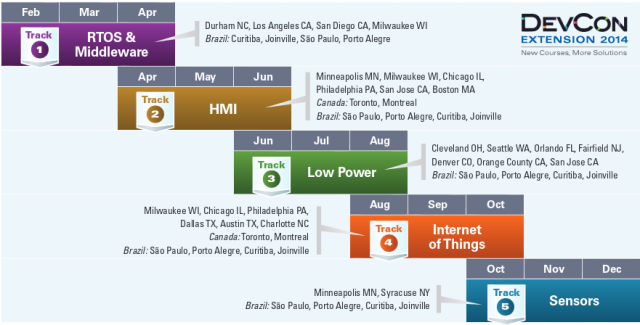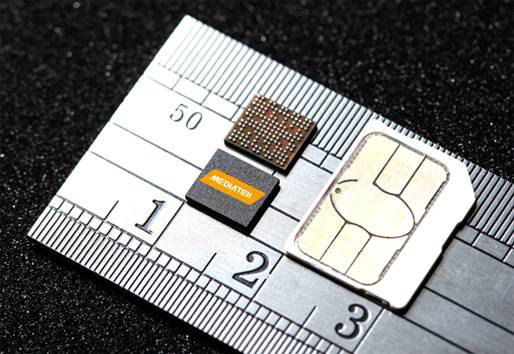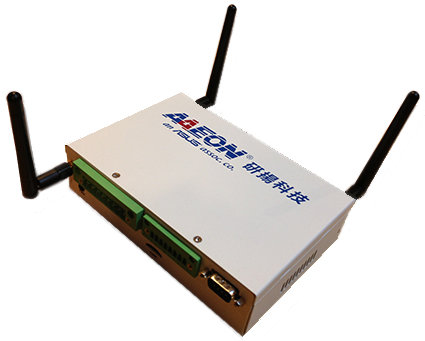Up until now, the only company I ever heard running Linux on ARM Cortex M3/M4 was EmCraft Systems with their system-on-modules and development kits based on Freescale Kinetis, STMicro STM32 and Actel Smartfusion micro-controllers. But there’s now another option thanks to Ampek Technologies, a Canadian based company funded in 2002, and their iCon (Internet Connectivity) board featuring NXP LPC1788 Cortex M3 connected to 64MB RAM which is plenty enough to run uCLinux. The board can be used for applications such as industrial control systems, wireless sensors, or smart home appliances. The iCon board specifications are as follows: MCU – NXP LPC1788 ARM Cortex-M3 MCU @ 120MHz with 512 KB flash memory, and 96 KB SRAM System Memory – 64MB SDRAM (external chip) Storage – 32MB flash for firmware Connectivity – 802.11 b/g/n, Bluetooth 4.0. Ethernet is supported via an add-on module USB – USB 2.0 host port, mini-USB debug port […]
Review of Broadlink SP2 Wi-Fi Smart Plug
I have received Broadlink SP2 Wi-Fi smart socket for Android and iOS thanks to GearBest, a Chinese e-retailer, that was kind enough to send a sample for review. I’ll start by showing some pictures of the package and device, and report the results of my review with an Android phone (ThL W200). Broadlink SP2 Unboxing Pictures The company send me the parcel via DHL, and I received in the package below, the top with the picture, and the bottom with specifications in Chinese. There’s only the smart plug in the package. The top is a universal plug, but the bottom is a Australian/ Chinese plug, so most people would need a wall adapter. It support 110 to 240V AC up to 10 amperes, consumes less than 0.5W without load, and it designed to handle 50,000 on/off events. The thing that surprised me was the size of the plug at first, […]
Advantech UTX-3115 Rugged Fanless Computer Powered by Intel Atom E3826 SoC Supports Intel Intelligent Systems Framework
Advantech UTX-3115 is a rugged low power fanless computer powered by Intel Atom “Bay Trail-I” E3826 dual core processor and lots of various ports that can be used as a digital signage, for machine or factory automation, & “smart IoT gateway”, and that happens to be supported by Intel’s Intelligent Systems Framework (ISF). Before checking out Intel ISF, let’s go Advantech UTX-3115 hardware specifications: SoC – Intel Atom E3826 dual core processor @ 1.46 GHz with 1MB L2 cache and Intel HD graphics. System Memory – 2 x 204-pin SO-DIMM DDR3 1333/1066MHz, up to 16GB Storage – 2.5″ bay for HDD or SSD storage Video Output 1x HDMI up to 1080p60 1x micro HDMI up to 1080p60 1x VGA up to 2560 x 1600 @ 60Hz Dual channel LVDS up to 1920 x 1200 @ 60Hz (shared with micro HDMI) Connectivity – Dual Gigabit LAN (LAN1: Intel I210AT, LAN2: Realtek […]
Renesas DevCon Extension Organizes Free One-Day Courses About IoT, Low Power, Sensors and More
I’ve just come across a YouTube video called Ultra-Low-Power Solutions for Wearable Technology and the ‘Internet of Things’ On Renesas channel. The video itself promotes Cymbet EnerChip Solid State Batteries and Kits, working together with Renesas MCUs, and the interesting part is that they’ll provide a free training session for the kit as part of Renesas Devcon Extension 2014. This is not a single event as you may think, but instead the company hosts one-day workshops in various cities in the US and Brazil covering various tracks all year long, as you can see in the simplified schedule below. RTOS & Middleware track is not available anymore, but you can still attend training sessions for Human Machine Interfaces, Low Power designs, the Internet of Things and Sensors. As an example, the following lectures are available for the Low Power track: Renesas Low-Power MCU Lineup (30 minutes) – Updated technology roadmap […]
MediaTek Unveils LinkIt Platform with MT2502 Aster SoC for Wearables and IoT Applications
After Ineda Systems Dhanush SoC and SHASTRA Devkit, here’s another Wearable SoC and development kit for today with Mediatek announcement of their LinkIt platform providing both hardware and software to develop wearables and IoT applications using their Aster SoC for wearables. Key features of LinkIt platform listed on Mediatek Labs: MediaTek Aster (MT2502) measures only 5.4 x 6.2mm and is specifically designed for wearable devices Developer platform supported by reference designs that enable creation of various form factors, functionalities and internet connected services Synergies between microprocessor unit and communication modules, facilitating development and saving time in new device creation Modularity in software architecture provides developers with high degree of flexibility Supports over-the-air (OTA) updates for apps, algorithms and drivers Plug-in software development kit (SDK) for Arduino and VisualStudio; planned (Q4 2014) support for Eclipse Hardware Development Kit (HDK) based on LinkIt board by third party No details have been provided for […]
Aaeon AIOT-X1000 Linux Gateway is Powered by an Intel Quark SoC
Intel Quark SoC for low power embedded devices has been seen on platforms designed by Intel themselves, such as Intel Galileo board or Edison wearable development kit, but I had not found Quark SoC in actual products until Aaeon announced their AIOT-X1000 gateway for the internet of things running Linux on an Intel Quark X1000 SoC, and working with a Cloud Service by Asus, Aaeon’s parent company. The solution targets manufacturing, transportation, and energy applications. Aaeon AIOT-X1000 specifications: Processor – Intel Quark X1000-series SoCs @ up to 400 MHz System Memory – 1GB DDR3 800/1066 SODIMM Storage – IDE port, and micro SD slot Connectivity – 10/100M Ethernet USB 4x USB2.0 ports Serial – 1x RS-232/422/485, 1x RS-422/485 Other I/Os — I2C, GPIO, JTAG Mini-PCIe card expansion – 1x full-size and 1x half-size, allowing for WiFi, 2G/3G/LTE cellular, Bluetooth, CAN bus, ZigBee, and RFID add-on boards Power – 5V or 9-24V DC input Dimensions – 146 x […]
WifiDuino Arduino Compatible Wi-Fi Board Features an Optional OLED Display (Crowdfunding)
Getting Wi-Fi with Arduino can be relatively expensive, and may take a little too much space. Spark Core board greatly addressed both price ($39) and form factor issue last, but there’s another option coming to market thanks to WifiDuino a $34 board with Wi-Fi, that’s tiny and Arduino compatible. An OLED display is also available as an option, at a lower price point than MicroView board, and including Wi-Fi or not, depending on the perk. WifiDuino hardware specifications: MCU – Atmel Atmega32U4 (same as Arduino Leonardo) Display – Optional 128×64 OLED display Connectivity – Optional Wi-Fi 802.11 b/g with STA, AP and ADHOC network modes Digital I/Os – 20 Analog I/Os – 12 Other I/Os – 7x PWM, UART, I2C, SPI Power – 5V Dimensions – Duino board only without Wi-Fi nor OLED: 25.6mm x 38.8mm x 11.0mm WifiDuino support the Arduino IDE, so you can write you sketch as […]
AsiaRF AWM002 Wi-Fi Module and a Tiny IoT Server Kit Get Crowdfunded for $15 and Up
VoCore Wi-Fi module selling for $15 to $20, and it’s corresponding VoCore Dock with Ethernet has been quite popular, and at the time of writing, the project has already received $40,000 in funding with 50 more days to go. But if you’d rather get something for the same price, a few months early, and an already FCC/CE certified and proven module and tiny IoT server, AsiaRF has also launched a crowdfunding campaign for their AWM002 Wi-Fi module running OpenWRT on the same Ralink RT5350 found on the VoCore. as well as AWM002 Tiny Kit which adds Ethernet and USB, and a larger board with easier access to all ports and I/Os. As a reminder, let’s go through AWM002 specifications again: SoC – Mediatek/Ralink RT5350 MIPS 74KEc core @ 360 MHz dual band 802.11n Wi-Fi with data Rate up to 150Mbps, hardware NAT, QoS, TCP/UDP/IP checksum offloading. System Memory – 32 MB Storage […]


